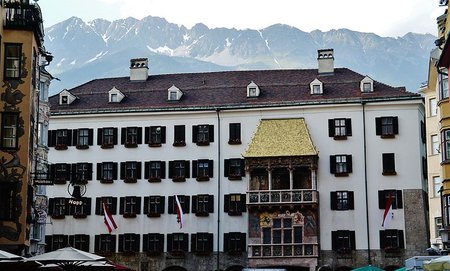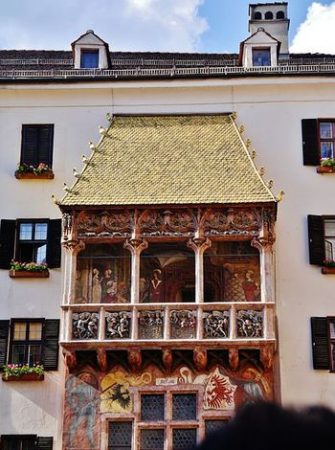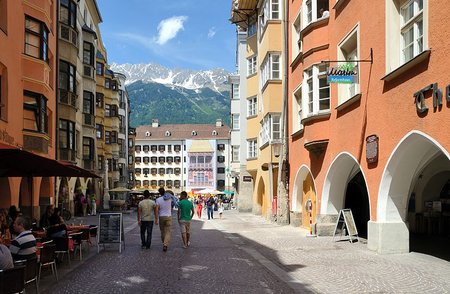The Goldenes Dachl or the Golden Roof stands right in the middle of Innsbruck royal land. This was where the counts, dukes and members of royalty used to stay and most of the buildings around here are Goth / Renaissance style wonders. The Goldenes Dachl however overshadows all buildings… such is the brilliance of its 2657 fire gilded copper tiles.
The 15th century created building facade is decked with an Oriel that bears sculpted reliefs and mural paintings. There are prominent figures of Emperor Maximilian and his second wife Bianca Maria Sforza (the Golden roof was built to celebrate their wedding) but the emperor’s first wife ‘Mary of Burgundy’ is also shown standing at the other side of the emperor.

The Goldenes Dachl was meant for the emperor’s people watching hours… his majesty and his royal entourage would sit down on the fantastically decorated balcony and look at tournaments and dramas that took place in the square below. Inside there is a small museum devoted to the emperor and the history of this building but to know the Goldenes Dachl truly you should also know the Herzog Friedrich Straße and its history. This is one of those monuments that’s appreciated better in retrospect… once the stories and fascinating history behind the area is known to you, the Goldenes Dachl will seem more than just a ‘Golden Roof’.
History
The building that contains the Goldenes Dachl was created on the instructions of Archduke Friedrich IV at the beginning of the 15th century as the residence of the imperials. But it was Emperor Maximilian I who commissioned the building of the loggia in 1493 and it was Innsbruck’s gifted court builder Nikolaus Turing (elder) who was entrusted with designing it. Incidentally, Nikolaus is the same builder who created the later modifications and enlargements to the beautiful Hofburg.
The occasion of building the Goldenes Dachl was the emperor’s marriage to Bianca Maria Sforza. The idea of creating a golden roof with 2657 fire gilded copper tiles was a unique one and till today the roof blinds onlookers with its reflected light when the sun rays hit directly on it. The ‘Golden Roofed House’ was meant to be a luxurious royal box where the emperor and his loyal entourage would sit and look at tournaments and enjoy festivities that took place in the square below. Egoistic Maximilian also wanted to thwart rumours about the imperial financial crisis… to understand the megalomaniac Emperor better, you must visit the Hofkirche.
While visiting the Goldenes Dachl, it’s important to understand why this particular building on the Herzog Friedrich Straße was chosen for hosting the Emperor. The Herzog Friedrich Straße (or Strasse) was always the most important route for traffic flowing in from the southern parts (Brenner, Wilten) and inside the city. In the olden ages, it was the only crossing over the river Inn within the extended region of Innsbruck. The current position and layout of the Herzog Friedrich Straße dates back to the 12th century…. to the era of the Tyrolean counts. In those days the street used to stretch till the Inntor ruins to the Vorstadttor wrecks.
It was in the 15th century though, that most of the Goth and Renaissance-style buildings sprung up and they were mostly created by the Turing family of builders. When visiting the Goldenes Dachl area, you will notice that the first floor of most buildings extends over the street and graceful archways are created… this was done basically to increase the living space. Most of the buildings also sport finely crafted frescoes.
The square in front of the Golden Roof held many public events and exhibitions besides tournaments and performances. In the 15th century Jakob Hutter was burned at the stake here on the charges of being a Heretic. In 1964 and 1976 the winter Olympics were held in Innsbruck and medals were presented to victorious athletes at this square. Since 1972 the Herzog Friedrich Straße serves as a pedestrian street/zone.
Right now the Museum contains a small but insightful museum; the Maximilianeum as well as the Innsbruck City Archives. Since March 2003, Goldenes Dachl hosts the International Alpine Convention’s Office. The Alpine Convention is a group of 8 Alpine countries that are dedicated to sustainable development in the European Alps area. The spectacular appearance of the roof has inspired many filmmakers to use it as a set. In 2017, the roof was featured in a popular Bollywood movie ‘Tiger Zinda Hai’.
What to See & Do
The Goldenes Dachl is one of the most photographed buildings of Europe and it’s certainly the most recognisable landmark of the city. It looks spectacularly beautiful both in the evening and the morning and it’s worth paying a double visit to this part of the old town just to take some fabulous pictures.
The bay itself is 16 m wide and the roof is 3.7 m high. The roof was tiled with 2657 shingles of pure gilded copper but the original tiles were all removed and replaced with lookalike copies in the 20th century. The original tiles (6 of them) can be looked at in the Golden Roof Museum.

The fringe of the roof overlays many beautiful reliefs. The most recognisable 3 figures are the emperor Maximilian himself and his two wives Bianca Maria Sforza (2nd wife) and Mary of Burgundy (first wife). Maximilian apparently didn’t want to disturb the political alliance he had formed with Burgundy with his first marriage which is why he is shown diligently standing between his two wives in the relief. There are many small twisting figures around the emperor’s family… these are Morris dancers/ mediaeval Breakdancers. There is an inscription on the building that speaks about its history.
Right beneath the balcony, there is a series of reliefs featuring two knights. One holds the flag of the Holy Roman Empire while the other holds the flag of Tyrol… showing the strict loyalty of the emperor’s dynasty to Tyrol and the Holy Roman Empire. Right under the knights, there are coats of arms that show the acquired territories of Maximillian.
Closely watching the beautiful building is a good activity and is a completely free thing to do. However, if you want to experience a reduced version of Maximilian’s own vantage point then you need to get up there on the balcony. You can do that by paying a small fee and imagine yourself being a member of Tirol’s royal family while you look down at the hustle and bustle of ‘commoners’.
Remember, that you won’t be allowed inside the main balcony as it’s a protected area. However, there is a smallish viewing area with mirrors laid down in the ground that gives visitors good visibility of the lovely paintings that deck the walls and ceilings of the balcony.
What you see inside the Golden Roof building is not the original version… this is fully plastered and has dropped ceilings plus modern flooring (a product of a major renovation project). There is only one room inside that preserves the original medieval architecture.

The Golden Roof Museum is an interesting museum that showcases the emperor’s life. It will take a maximum of half an hour to go through this interesting museum that has multimedia interactive exhibits about the emperor’s court and personal life.
There are kids stations designed to entertain kids of all age groups and a special mystery rally. There is a small informative film that keeps on running continuously and you can watch it to gain more insight into the articles that are on display in the museum.
There is an audio guide in several languages (including English) provided to each visitor and that itself runs for close to 45 minutes. There are multiple maps inside and a full-sized model of Maximillian.
There is an interesting feature of the museum that offers to send an ecard to anyone of your choice… there are lots of Maximillian themed images and pre-printed messages you can choose from.
If you have limited time on your hand then there is really no need of going up to the Golden Roof Museum unless it’s for the experience of taking a selfie on the famed balcony. Content-wise, the Hofkirche will tell you more about Maximilian than this museum. However, a picture on the balcony under the Golden Roof is considered to be a ‘must do’ activity while one is at Innsbruck… and taking that picture means that you anyway have to pay the 4 euro entry fee.
From 1965, the Innsbruck Christmas Market (Christkindlmarkt) is held on the Herzog Friedrich Straße. The market is on for the whole of December and provides a unique and picturesque shopping experience. There are plenty of cafes around this area too which provide a great view of the golden roof… the coffee/ hot chocolate won’t be cheap but some tourists may prefer spending their money here rather than going up to the museum.
Roaming around the Herzog Friedrich Straße and admiring the Goth and Renaissance buildings around is a must-do activity. This was the city’s most affluent political vein and the financial power hub. Till this day the important activities of the city like medal presentation ceremonies, triumphal marches etc. are held here.
Note: there are no restrooms inside the Golden Roof Museum but there is a Swarovski Crystal shop on the basement level that has restrooms.
Tickets & Tours
The entry fee for an adult to the viewing balcony and the Golden Roof Museum is 4 euros. The entry fee includes an audio guide (multi-lingual) for the museum and access to the viewing area on the Golden roof balcony. An entry fee is not required for holders of the Innsbruck Card and the Museum Mobilcard.
You can find several groups and private city tours with a stop at Golden Roof, check rates and book online through this Viator site.
Open Hours
The golden roof museum timings are as follows:
- From 1st October to 30th April the Golden Roof museum and viewing area is open from Tuesday to Sunday (10:00 am – 5:00 pm) while from 1st May to 30th September the timings are Monday – Sunday (10:00 am – 5:00 pm)
- Almost every year, the museum is closed for the entirety of November so that’s a bad time to visit if you are targeting a look inside the museum.
It’s best that you visit the Golden Roof before 9 am before the pedestrian trucks roll in or it’s best that you wait till late afternoon till the pedestrians take over the space completely and there are no commercial vehicles come into sight. The Golden Roof looks lovely at any time of the year but around Christmas, the ambience of this area becomes magical as lots of fairy lights are switched on and sometimes the Tyrolean Band plays traditional music right there on the Golden Roof balcony.
Location & Contacts
The Golden Roof is located at the terminus of Herzog Friedrich Strasse and is pretty much accessible by all modes of conveyance. There is a direct bus that goes from Innsbruck Hauptbahnhof and goes to Innsbruck Terminal Marktplatz (nearest bus stop) and the journey takes only 4 minutes. But if you are exploring the old town on foot (which you should) then it’s better that you walk to the Goldenes Dachl as almost all the buildings around the square are worth a look. From the train station, it will take you about 20 minutes to reach the old town.
Golden Roof
Herzog-Friedrich-Straße 15, 6020 Innsbruck
Phone: +43 512/53 60 14 41; Email: [email protected]
Many tourists prefer staying near the Goldenes Dachl as it’s the city’s most famous sight. Those who are anyway planning to stay in old town would do well to target a hotel that offers a good view of this beautiful monument so that they can capture the look of the Golden Roof at different parts of the day. Good hotel choices include Best Western plus Hotel Goldener Adler and Altstadthotel Weisses Kreuz.
After you are done exploring the Golden Roof you can see the Dom St Jakob and the Hofkirche. Otherwise, you can just wander around the area that’s filled with lovely baroque buildings… of special interest are the Mozart’s House and the Helinghaus at 10 number Herzog Friedrich Straße. The Town Tower/ Stadtturm is just steps away and has a nice viewing platform. There are plenty of unique small shops in the area and nice cafes (though the coffee is expensive) and it might be worth it to sip on a cup while admiring the splendid view. The mountain ranges flanking the old buildings provide really scenic shots. A shopping expedition to the famous Swarovski crystal store and the Christmas store selling lovely decorated Christmas eggs is especially recommended.
If you want to have a proper meal around here… there are plenty of options as Herzog Friedrich Strasse is full of restaurants and cafes. There is Altstadtbeisl on Herzog Friedrich straße-Hofgasse junction and it serves traditional Austrian food. Then there is Maria von Burgund (named after Maximillian’s first wife) on Herzog Friedrich Strasse 15 and it serves classic European food. There is Bottega di Parma serving classy Italian food and Katzung serving hot coffee and pastries.
For the best schnitzel in old town you should head off to the Piano… also on the same street. It’s logically possible to fill up an entire day’s worth of activity including sightseeing, eating, shopping and photography in and around this square and this is also probably the best place to indulge in Maximillian’s favourite hobby… people watching!!!
 A travel addict. Still celebrating the day when he quit his high-profile corporate job to pursue his passion for travel writing.
A travel addict. Still celebrating the day when he quit his high-profile corporate job to pursue his passion for travel writing.